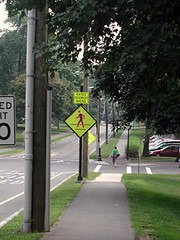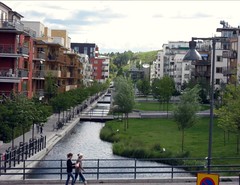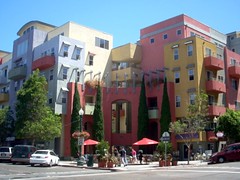Designing communities for health: tools and resources

Posted November 29, 2010 at 2:13PM
Three months ago, I wrote a post headlined “Why doesn’t the public health community get it about walkability?” Several commenters quite rightly took issue with that statement, pointing out all the ways in which health advocates do indeed get it, and are working hard and well on improving our built environment to encourage walking and other physical activity. What I should have written, of course, was something much more limited and directed not outward but toward my own community: why don’t more mainstream environmental-group health advocates care about walkability?
That was the real source of my frustration. But, really, it’s not just the health branch of the environmental world. The number of advocates in the mainstream environmental community who place a priority on neighborhood and regional design for any reason - health or otherwise - is pretty limited. (NRDC elevated sustainable communities to an institutional priority for the first time just this year.) With respect to the relationship between neighborhood form and public health specifically, the number becomes miniscule.
There is a significant current exception to the general rule that environmental groups don’t pay much attention to urban form. A number of philanthropic institutions have poured an astounding amount of resources into federal and state transportation policy issues in the last three years, and we’re definitely paying attention. Transit, regional planning, even telecommuting in order to reduce driving are now on enviros’ radar screens in a big way. At NRDC the emphasis is largely but not exclusively on reducing emissions from driving.
 But I would argue that even with the emphasis on transportation there is still scant attention paid in our community to neighborhood-scale factors that can influence walking - street connectivity, mixed uses, sidewalks, and the like. Here we come closest with advocacy for complete streets, but even that praiseworthy effort has been described to me by one of its leaders as “a political movement, not a design movement.” On-the-ground efforts under the banner of complete streets are frequently directed at converting arterial streets and higher-speed roads into more multi-functional spaces. That’s a pretty significant objective in itself, by the way. But there isn’t much attention paid to what happens outside the street’s right-of-way.
But I would argue that even with the emphasis on transportation there is still scant attention paid in our community to neighborhood-scale factors that can influence walking - street connectivity, mixed uses, sidewalks, and the like. Here we come closest with advocacy for complete streets, but even that praiseworthy effort has been described to me by one of its leaders as “a political movement, not a design movement.” On-the-ground efforts under the banner of complete streets are frequently directed at converting arterial streets and higher-speed roads into more multi-functional spaces. That’s a pretty significant objective in itself, by the way. But there isn’t much attention paid to what happens outside the street’s right-of-way.
Beyond transportation, there definitely isn’t much if any attention paid in the environmental community to the effect of other aspects of community form and design on health. But that’s on us, not on other public health advocates, who are indeed showing leadership on the issue.
I just came across one terrific-looking set of resources, for example, called Design for Health. According to the web site, Design for Health and its online presence compose “a program that helps create and synthesize the evidence base linking landscape, urban design, planning, and health.” It is substantial.
The first phase of Design for Health was focused on planning in the Twin Cities region, where $25 million was provided by the last federal transportation law to develop and improve infrastructure for active living and active transportation, and where comprehensive plans for 19 municipalities were due for updates in 2008.
 The Twin Cities project resulted in an extensive set of core resources on such issues as air quality, access to food and health care, mental health, noise, physical activity, social capital, water quality, and special populations, with research summaries, tools, and links to a wealth of data and information. One of the resources that I found particularly interesting was a set of checklists designed to assist the integration of health concerns into planning for land use, transportation, water, parks and open space, redevelopment, and economic development.
The Twin Cities project resulted in an extensive set of core resources on such issues as air quality, access to food and health care, mental health, noise, physical activity, social capital, water quality, and special populations, with research summaries, tools, and links to a wealth of data and information. One of the resources that I found particularly interesting was a set of checklists designed to assist the integration of health concerns into planning for land use, transportation, water, parks and open space, redevelopment, and economic development.
Among the questions:
- Has a community food security assessment been created to [identify] barriers to healthy food, income levels, lost farmland, community gardens and farmer’s market availability within urbanized areas?
- Are there appropriate ordinances or policies used for mixed-use design of neighborhood, village, town, and city centers?
- Are there policies or incentives to encourage the redevelopment of brownfield sites?
- Does planning policy for redevelopment include evaluation of lead-bearing substances in exposed surfaces of dwelling units, child care facilities, schools, or recreation facilities used by children?
- Are all residential areas planned for an average of 4 (preferably 7) units per gross acre?
- Is a tree canopy provided in parks, open space, and streetscapes to establish a 50% to 100% canopy coverage in the redevelopment area?
 Are there policies that require that all developments have views of greenery for mental health benefits?
Are there policies that require that all developments have views of greenery for mental health benefits?- Are there development and landscape design standards for water (i.e. green roofs, encouraging rain gardens, buffer thresholds, ordinances for pervious pavement)?
- Are there existing or planned vegetated buffers along all water bodies (preferably 20m to 50m) to prevent non-point pollution from impervious surfaces?
- Do the pedestrian overlay zones include policies that encourage walking and bicycling through streetscape amenities such as benches, trash receptacles, planters, pole lights, kiosks, telephones, newsstands, drinking fountains and bike racks?
- Are there urban design guidelines that relate to sidewalk width and materials, lighting, signage, landscaping, way finding, crosswalks, curb ramps, refuge islands, corner radii, and signals?
- Is regular transit service planned for all residential and employment areas (preferably within 1200m of all residential areas)?
- Are there plans or policies to provide adequate street lighting along all major streets?
 Are there a variety of nearby destinations for residents (e.g., employment, health care, grocery stores, etc.) and can these destinations be reached by a variety of transportation modes (e.g., bicycling, walking, automobile, transit)?
Are there a variety of nearby destinations for residents (e.g., employment, health care, grocery stores, etc.) and can these destinations be reached by a variety of transportation modes (e.g., bicycling, walking, automobile, transit)?
There are eleven pages of questions in various categories and rank of importance, and they are all good ones. (That said, I would strongly urge that the Design for Health team spend some time proofreading and copy editing. There are a lot of errors that distract the reader.)
In addition to these very good resources, Design for Health provides tools for health impact assessment, conducts training workshops, and is available for direct technical assistance. There is also an interesting-looking blog called Healthy Metropolis that is maintained by Ann Forsyth, the professor of city and regional planning at Cornell University who initiated Design for Health. Forsyth has partnered in the project with Kevin Krizek of the University of Colorado and Carissa Schively Slotterback of the Humphrey Institute at the University of Minnesota. The webmaster is Joanne Richardson.
I’m impressed with their work so far.
Move your cursor over the images for credit information.
